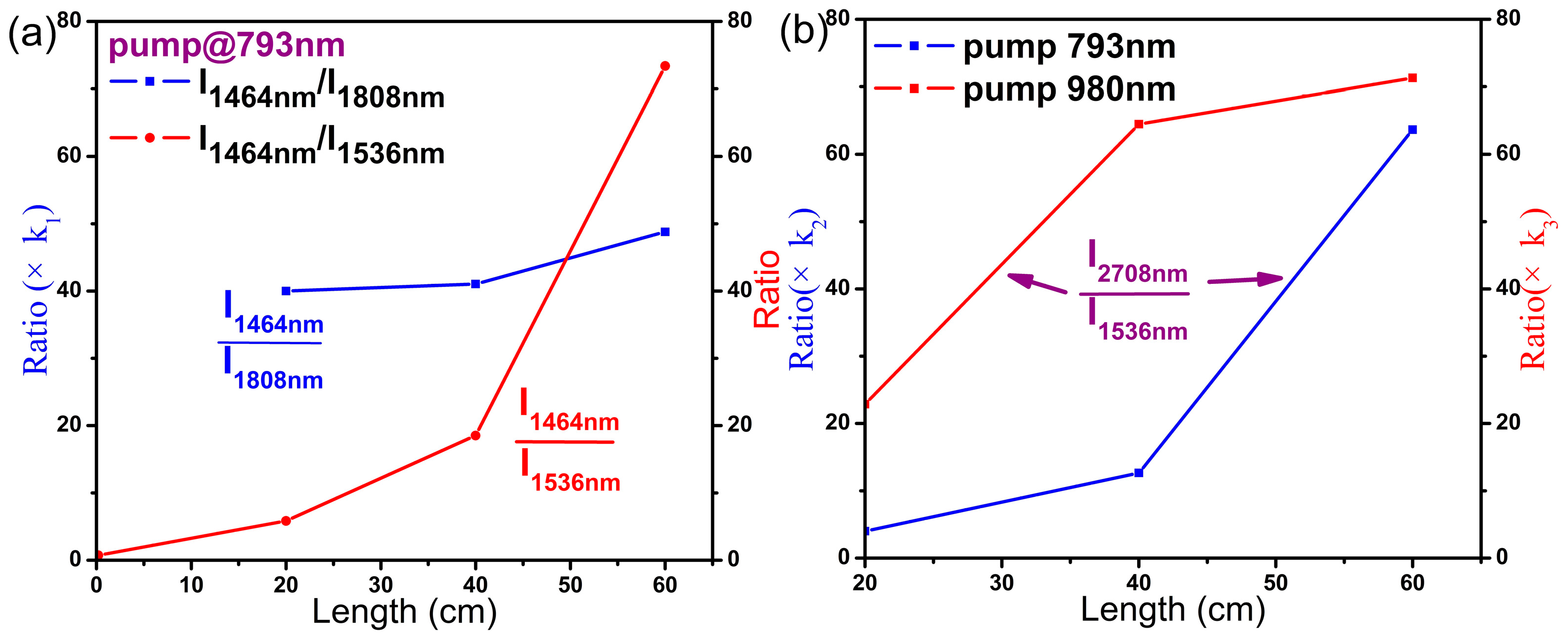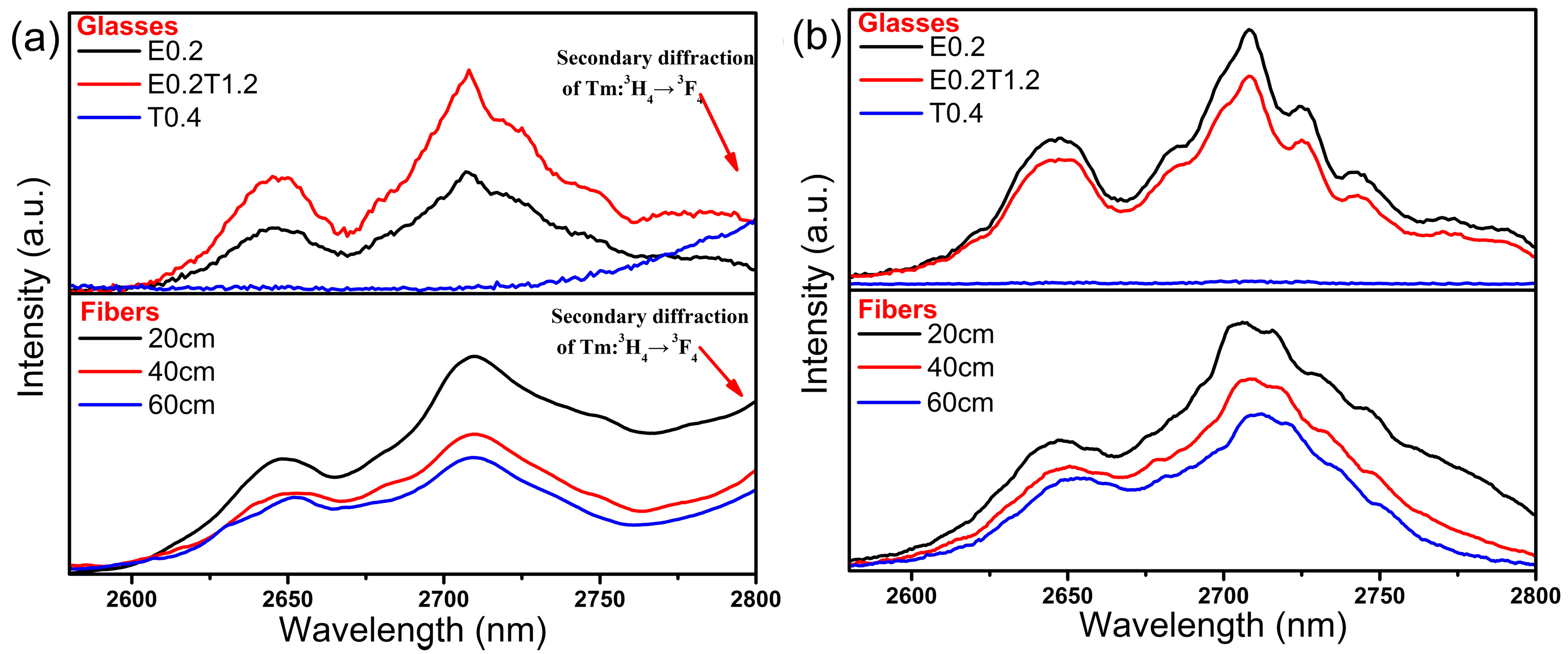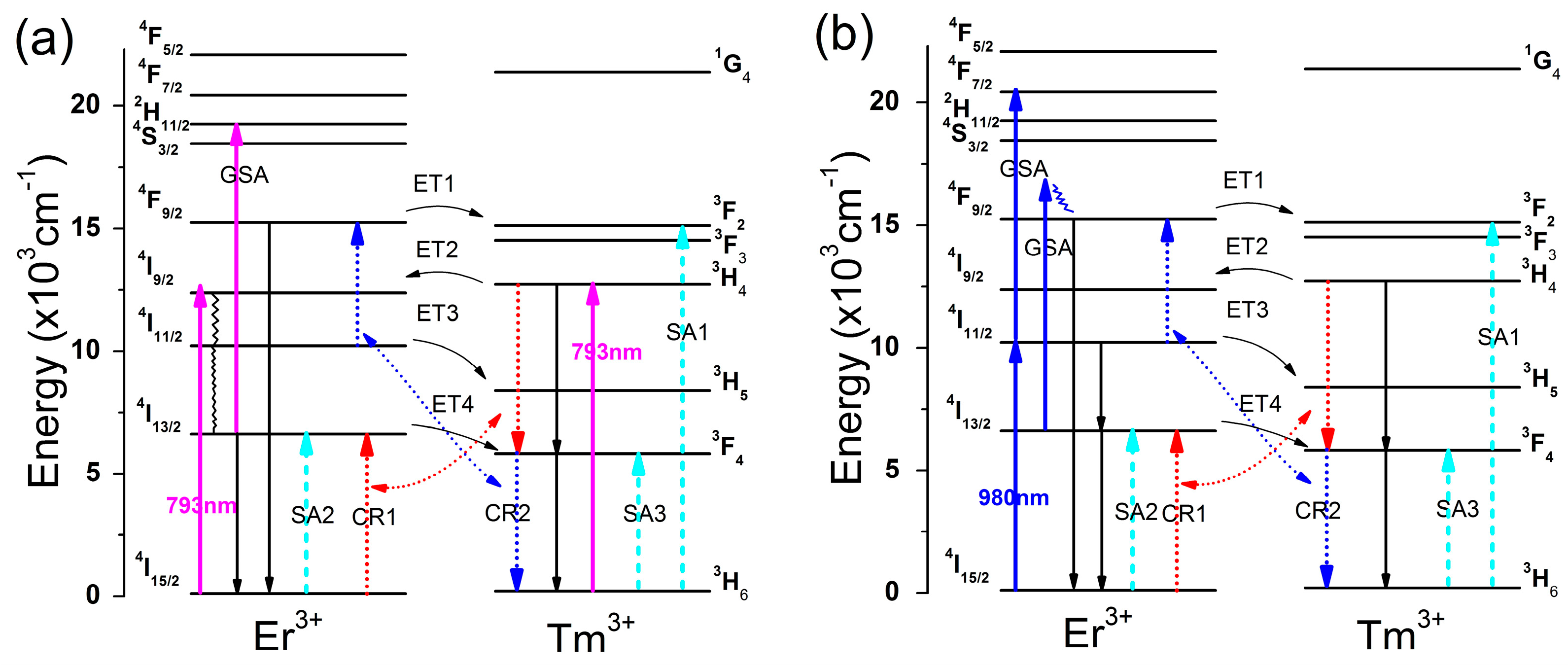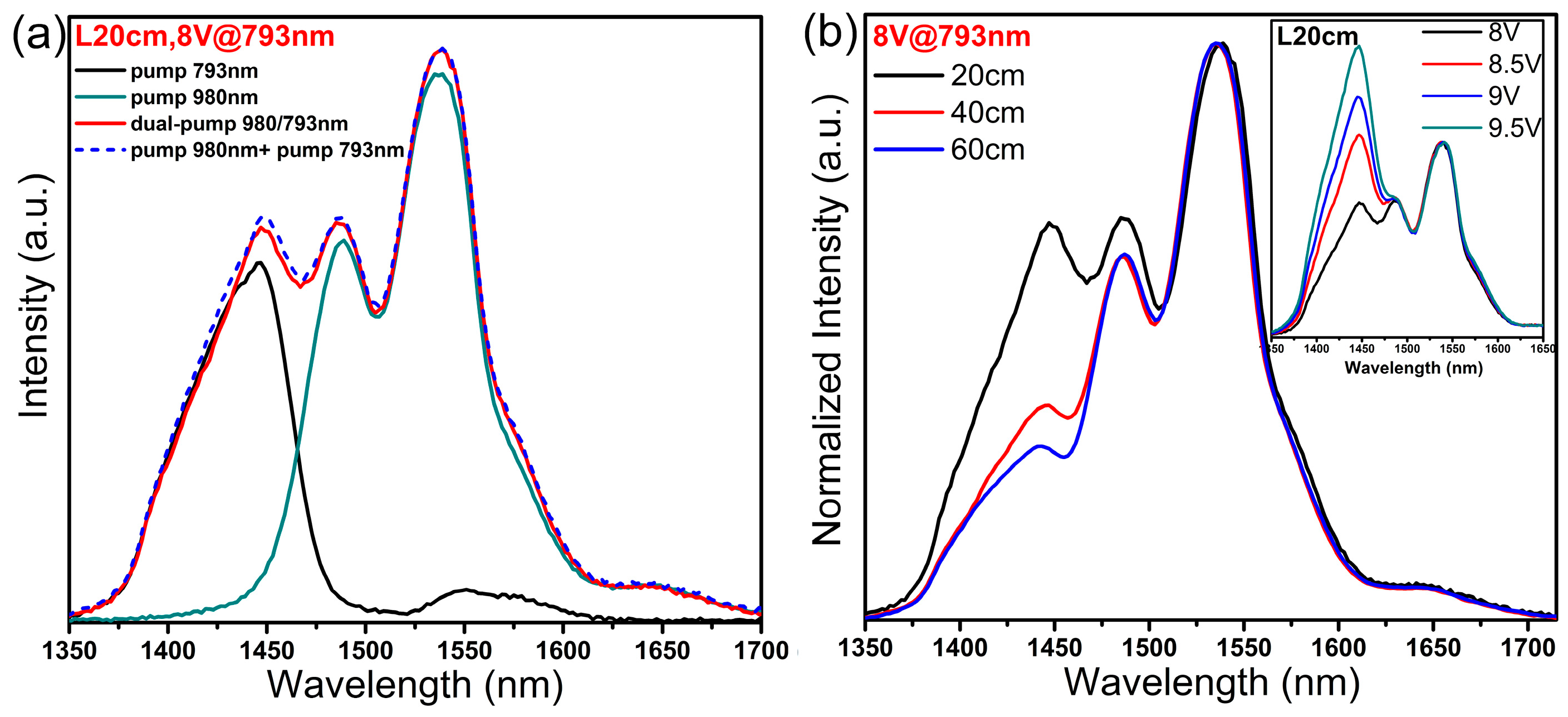Spectral Properties of Er3+/Tm3+ Co-Doped ZBLAN Glasses and Fibers
Abstract
:1. Introduction
2. Experimental
3. Results and Discussion
3.1. Thermal Stability
3.2. Absorption Spectra
3.3. Emission Spectra and Energy Transfer Mechanism
ET2: Er3+:4I15/2 → 4F9/2, Tm3+:3H4 → 3H6, 249 cm−1
ET3: Er3+:4I11/2 → 4I15/2, Tm3+:3H6 → 3H5, 1922 cm−1
ET4: Er3+:4I13/2 → 4I15/2, Tm3+:3H6 → 3H4, 892 cm−1
CR1: Er3+:4I15/2 → 4I13/2, Tm3+:3H4 → 3F4, 408 cm−1
CR2: Er3+:4I11/2 → 4F9/2, Tm3+:3F4 → 3H6, 583 cm−1
SA2: Er3+: 4I15/2 → 4I13/2
SA3: Tm3+:3H6 → 3F4
3.4. Dual-Pump for Broadband
4. Conclusions
Acknowledgments
Author Contributions
Conflicts of Interest
References
- Miguel, M.A.A.; Arriandiaga, R.; Morea, J.; Fernandez, J.; Gonzalo, R. Balda, Effect of Tm3+ codoping on the near-infrared and upconversion emissions of Er3+ in TeO2-ZnO-ZnF2 glasses. J. Lumin. 2014, 154, 136–141. [Google Scholar] [CrossRef]
- Xu, R.; Tian, Y.; Wang, M.; Hu, L.; Zhang, J. Investigation on broadband near-infrared emission and energy transfer in Er3+-Tm3+ codoped germanate glasses. Opt. Mater. Amst. 2011, 33, 299–302. [Google Scholar] [CrossRef]
- Li, K.; Fan, H.; Zhang, G.; Bai, G.; Fan, S.; Zhang, J.; Hu, L. Broadband near-infrared emission in Er3+-Tm3+ co-doped bismuthate glasses. J. Alloys Compd. 2006, 509, 3070–3073. [Google Scholar] [CrossRef]
- Jeong, H.; Oh, K.; Han, S.R.; Morse, T.F. Characterization of broadband amplified spontaneous emission from an Er3+-Tm3+ co-doped silica fiber. Chem. Phys. Lett. 2003, 367, 507–511. [Google Scholar] [CrossRef]
- Huang, L.H.; Jha, A.; Shen, S.X.; Liu, X.B. Broadband emission in Er3+-Tm3+ codoped tellurite fibre. Opt. Express. 2004, 12, 2429–2434. [Google Scholar] [CrossRef] [PubMed]
- Chillcce, E.F.; Rodriguez, E.; Neves, A.A.R.; Moreira, W.C.; César, C.L.; Barbosa, L.C. Er3+-Tm3+ co-doped tellurite fibers for broadband optical fiber amplifier around 1550 nm band. Opt. Fiber Technol. 2006, 12, 185–195. [Google Scholar] [CrossRef]
- Balda, R.; Fernández, J.; Fernández-Navarro, J.M. Study of broadband near-infrared emission in Tm3+-Er3+ codoped TeO2-WO3-PbO glasses. Opt. Express 2009, 17, 8781–8788. [Google Scholar] [CrossRef] [PubMed]
- Tanabe, S. Optical properties and local structure of rare-earth-doped amplifier for broadband telecommunication. J. Alloys Compd. 2006, 408–412, 675–679. [Google Scholar] [CrossRef]
- Hadi, M.; Marvasti, F.; Pakravan, A.M.R. Dispersion compensation using high-positive dispersive optical fibers. Chin. Opt. Lett. 2017, 15, 30601. [Google Scholar] [CrossRef]
- Boguslawski, J.; Sotor, J.; Sobon, G.; Kozinski, R.; Librant, K.; Aksienionek, M.; Lipinska, L.; Abramski, K.M. Graphene oxide paper as a saturable absorber for Er-and Tm-doped fiber lasers. Photonics Res. 2015, 3, 119–124. [Google Scholar] [CrossRef]
- Tanabe, S. Rare-earth-doped glasses for fiber amplifiers in broadband telecommunication. Comptes Rendus Chim. 2002, 5, 815–824. [Google Scholar] [CrossRef]
- Zhang, J.; Dai, S.; Li, S.; Xu, S.; Wang, G.; Hu, L. Characterization of broadband amplified spontaneous emission of erbium-doped tellurite fiber with D-shape cladding. Mater. Lett. 2004, 58, 3532–3535. [Google Scholar] [CrossRef]
- Seo, S.Y.; Shin, J.H.; Bae, B.S.; Park, N.; Penninkhof, J.J.; Polman, A. Erbium-thulium interaction in broadband infrared luminescent silicon-rich silicon oxide. Appl. Phys. Lett. 2003, 82, 3445–3447. [Google Scholar] [CrossRef]
- Zhou, D.; Song, Z.; Chi, G.; Qiu, J. NIR broadband luminescence and energy transfer in Er3+-Tm3+-co-doped tellurite glasses. J. Alloys Compd. 2009, 481, 881–884. [Google Scholar] [CrossRef]
- Zhao, G.; Tian, Y.; Wang, S.; Fan, H.; Hu, L. Broadband near-IR emission and temperature dependence in Er/Tm co-doped Bi2O3-SiO2-Ga2O3 glasses. Phys. B Condens. Matter. 2012, 407, 4622–4626. [Google Scholar] [CrossRef]
- Yan, B.; Luo, Y.; Zareanborji, A.; Xiao, G.; Peng, G.D.; Wen, J. Performance comparison of bismuth/erbium co-doped optical fibre by 830 nm and 980 nm pumping. J. Opt. 2016, 18, 105705. [Google Scholar] [CrossRef]
- Tian, Y.; Xu, R.; Hu, L.; Zhang, J. 2.7μm fluorescence radiative dynamics and energy transfer between Er3+ and Tm3+ ions in fluoride glass under 800 nm and 980 nm excitation. J. Quant. Spectrosc. Radiat. Transf. 2012, 113, 87–95. [Google Scholar] [CrossRef]
- Huang, F.; Liu, X.; Li, W.; Hu, L.; Chen, D. Energy transfer mechanism in Er3+ doped fluoride glass sensitized by Tm3+ or Ho3+ for 2.7 μm emission. Chin. Opt. Lett. 2014, 12, 51601. [Google Scholar] [CrossRef]
- Hu, L.; Chen, S.; Tang, J.; Wang, B.; Meng, T.; Chen, W.; Wen, L.; Hu, J.; Li, S.; Xu, Y.; et al. Large aperture N31 neodymium phosphate laser glass for use in a high power laser facility. High Power Laser Sci. Eng. 2014, 2, e1. [Google Scholar] [CrossRef]
- Poulain, M.; Poulain, M.; Lucas, J. Verres fluores au tetrafluorure de zirconium proprietes optiques d’un verre dope au Nd3+. Mater. Res. Bull. 1975, 10, 243–246. [Google Scholar] [CrossRef]
- Jackson, S.D. Towards high-power mid-infrared emission from a fibre laser. Nat. Photonics 2012, 6, 423–431. [Google Scholar] [CrossRef]
- Wang, X.; Li, Z.; Li, K.; Zhang, L.; Cheng, J.; Hu, L. Spectroscopic properties and energy transfer in Er-Tm co-doped bismuth silicate glass. Opt. Mater. Amst. 2013, 35, 2290–2295. [Google Scholar] [CrossRef]









© 2017 by the authors. Licensee MDPI, Basel, Switzerland. This article is an open access article distributed under the terms and conditions of the Creative Commons Attribution (CC BY) license (http://creativecommons.org/licenses/by/4.0/).
Share and Cite
Liao, X.; Jiang, X.; Yang, Q.; Wang, L.; Chen, D. Spectral Properties of Er3+/Tm3+ Co-Doped ZBLAN Glasses and Fibers. Materials 2017, 10, 486. https://doi.org/10.3390/ma10050486
Liao X, Jiang X, Yang Q, Wang L, Chen D. Spectral Properties of Er3+/Tm3+ Co-Doped ZBLAN Glasses and Fibers. Materials. 2017; 10(5):486. https://doi.org/10.3390/ma10050486
Chicago/Turabian StyleLiao, Xili, Xiaobo Jiang, Qiuhong Yang, Longfei Wang, and Danping Chen. 2017. "Spectral Properties of Er3+/Tm3+ Co-Doped ZBLAN Glasses and Fibers" Materials 10, no. 5: 486. https://doi.org/10.3390/ma10050486
APA StyleLiao, X., Jiang, X., Yang, Q., Wang, L., & Chen, D. (2017). Spectral Properties of Er3+/Tm3+ Co-Doped ZBLAN Glasses and Fibers. Materials, 10(5), 486. https://doi.org/10.3390/ma10050486




